Projects
Don Eduardo’s Cabin
This site was ultimately Edward James’s bedroom, used as a study and for his pets’ convenience. He wrote a poem on one of its walls, inspired by his garden—which makes this poem important indeed.
The poem required urgent attention and therefore the foundation intervened as part of its first major conservation work in 2009, stabilizing its presence on the wall and returning walls to their original finish by means of an expert group that came to the site expressly to do the work.
Other parts of the cabin also needed intervention. The wood floor in what was once the studio was extensively damaged, the foundation was corrected, and the walls’ original bamboo was replaced with new, specially treated bamboo.
Spanish sculptor José Horna designed a wooden furnishing for the cabin that served as a habitation for James’s boa constrictors; its restoration was also part of important works undertaken.
It was thanks to support from the World Monuments Fund and Friends of Heritage Preservation that the conservation of this historic and important space was possible.
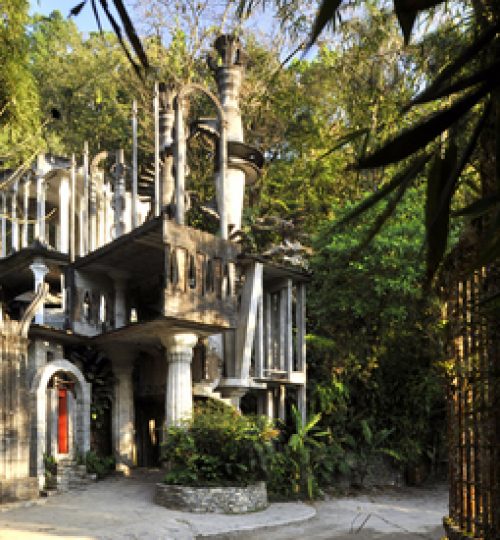
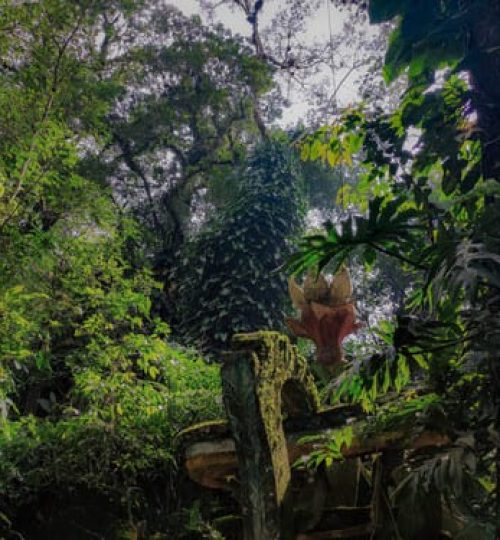
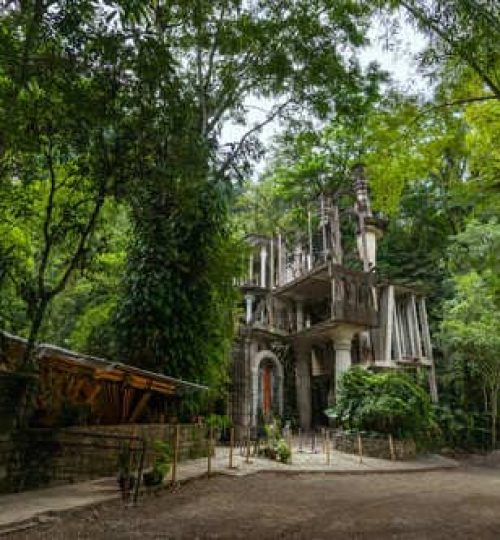
The three-story house that could have five
ALSO KNOWN AS THE CASA DE LAS CHIMENEAS OR THE CASA DE LOS HOYOS.
This structure—considered one of the most emblematic among the 36 most notable structures in the sculpture garden—was designed by Edward James, it is said anecdotally, to host his intimate friend Desmon Guiness, with the idea that he could enjoy the adjacent landscape and its waterfall with James from any of the terraces that make up the body of the structure, which features wide visual dominance over the nearby arroyo, falls and surrounding mountains, as well as a view of certain notable structures such as Plaza San Eduardo, the Palacio de Bambú, the Puente Roto and others.
The terraces that form the house served as an inspiration for Edward James to design other structures, write poetry and compose extensive letters to friends that could go on for as much as sixty pages.
FACTORS THAT PUT THIS ARCHITECTURAL GEM AT RISK
1988’s Hurricane Gilbert was the cause of a landslide that affected the structure and occasioned major damage by structurally compromising a number of columns and walls and destroying a concrete plate that crossed drainage zones.
This landslide was the result of water-saturation in loose material that—given the landscape’s natural slope—gave way to cause severe damage. It should be noted that the structure is situated over a natural earthen drain in a bridge-like fashion; when the drain was blocked, the slide destroyed the bridging plate, exerting pressure on the building.
RESTORATION
This includes building new joists and repairing existing ones. Joists and columns form the structure’s skeleton. All the new elements will serve to lend structural coherence and interlink those that are currently working independently, which is unsuitable and could lead to further damage in the future.
The work being done is necessary to keep the building from collapsing, which would destroy a large part of Edward James’ legacy, given that this is one of the site’s most representative structures and has a long history.
Concerned about the possible loss or further deterioration of this building and the lack of available resources, the Pedro and Elena Hernández Foundation, began seeking funding for its restoration, and finally found backing from the World Monument Fund and Wilson Challenge.
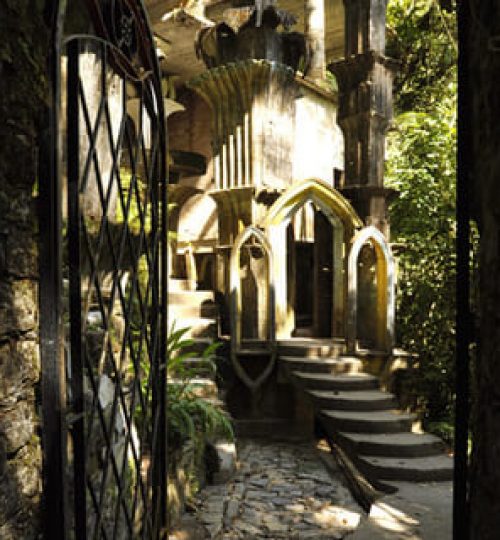
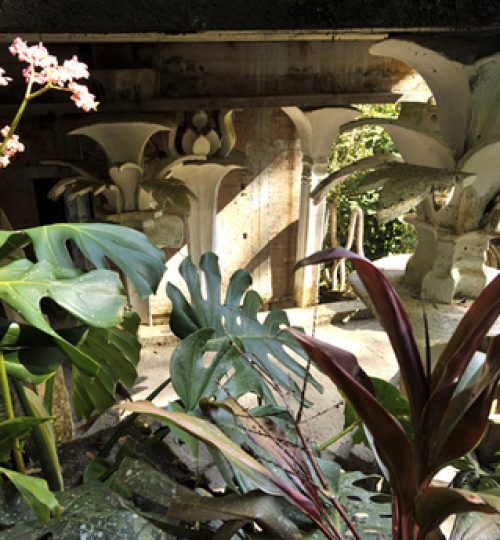

Arachnologists of the UNAM
Biological inventories serve to document the species inhabiting an ecosystem so we can begin to understand their interactions, importance and use of resources. Spiders form part of the order Araneae, which is recognized as one of world’s richest in terms of number of species: approximately 42,000 recorded species, representing half to one fifth of the estimated quantity of species. Most new discoveries inhabit subtropical and tropical regions. Mexico is of prime biological importance for this and other groups of organisms given that it is a transitional region between temperate and tropical zones, with highly variable terrain, and also because there have been few inventories of its spider population. Thus, it is likely that future studies will discover new species and extend the distribution range of previously identified species.
Woodland conservation and responsible management of natural resources is of key importance to the preservation of such biodiversity. Las Pozas is a high evergreen forest, under conservation for at least the past twenty years, and surrounded by human settlements. It functions as a refuge for a number of species whose natural habitats have been altered. This was the motive of four visits to the region made in 2011 and 2012.
A total of 10,716 spiders were collected in Las Pozas, of which 4017 were adult specimens representing approximately 250 species. Experts estimate that this represents between fifty and seventy-five percent of the species that may inhabit the zone, rated by the Shannon-Wiener and Simpson diversity indices as H’=3.69 and D=0.954 respectively, indicating a high degree of diversity. Studies realized in other parts of the Sculpture Garden and surrounding areas complement this information. Previously, 155 species had been recorded in San Luis Potosí (Hoffmann 1976). The 250 species collected in Las Pozas are currently being identified to determine which ones are new sightings in the state, and which ones are entirely new species. Preliminary data indicate that there may be ten new species for science, and many species recorded for the first time in this state.
West Dean College
2011
In May, 2011, as part of the program West Dean College has created to strengthen links between the two entities and continue providing cultural support to the children of Xilitla, a second event took place around a course for fourteen students from two local elementary schools, María Concepción Villegas and Amado Nervo.
This time, over the course of two weeks, the children created an artisanal album that featured local recipes, drawings, Mexican songs, photos and more.
This time, over the course of two weeks, the children created an artisanal album that featured local recipes, drawings, Mexican songs, photos and more.
West Dean College students Abigail Uhteg and Mariana Barreda led the course.
2010
Over three weeks in the summer of 2010, a course was conducted at facilities in Edward James’s sculpture garden and featured participation on the part of 28 children from Xilitla’s María Concepción Villegas elementary school.
The project was entitled Festival de Verano Las Pozas-West Dean—“The Las Pozas-West Dean Summer Festival.”
Children who participated learned about protecting the environment, poetry, singing, San Luis Potosí’s huapango music, juggling, theatre and a number of other subjects; classes were led by Emma Dexter and Mariana Barrera, both West Dean College students, as well as by Nicole Matchette, a University of Pennsylvania conservation student, and other local teachers that joined the project.
Declaration INBA
RESOLUTION number 658 declaring the Xilitla Sculpture Compound an artistic monument.
[The margin bears the national seal of Mexico and the legend Estados Unidos Mexicanos Secretaría de Educación Pública—the United Mexican States Ministry of Public Education]
JOSÉ ÁNGEL CÓRDOVA VILLALOBOS, Secretary of Public Education, by the authority of Article 38, section XXI, of the Organic Law for Public Administration; the 2nd, 5th, 33rd and 34th Articles of Federal Law on Archaeological, Artistic and Historic Monuments and Zones and the 9th Article of Federal Law Regulation on Archaeological, Artistic and Historic Monuments and Zones, and
That Mexico’s artistic heritage should be preserved and expanded to protect the tangible goods that constitute Mexico’s cultural riches; and
That the Xilitla Sculpture Compound is found on property located within the local entity known as “La Conchita,” within the municipal jurisdiction of Xilitla, San Luis Potosí, and occupies an 89,800.12-square-meter surface area within that property; and
That the Xilitla Sculpture Compound was constructed by Edward James between 1960 and 1984; and that its sculptures form part of an overall architecture and sculpture concept that—within its jungle context and because of the random layout of its construction—are a fundamental and inherent part of the site’s meaning, noteworthy for its mastery of scale, form and proportion as well as for its free and casual use of color, that allow the compound to become a sensorial space that materializes Edward James’s illusions and fantasies; and
That the compound can be considered part of the surrealist tradition, characterized by the creation of fantastic artistic elements that are discordant with reality and that seek simultaneously to express the reality of thought, free of aesthetic or coherent imperatives, aided only by imagination, sensations and perceptions that arise previous to the moment of creation; and
That this compound is noted for its use of artisanally made, wooden, botanical-form contours as well as its use of reinforced concrete (as apparent in its finishes) as petrified dreams within a natural garden that—via artistic creation—contributes significant characteristics to the site and is additionally a compound in which the natural environment and human creations constitute an exceptional cultural landscape; and
That between 1964 and 1967 the distinguished painter Leonora Carrington, of English origins, visited the property and left testimony in the form of a fresco mural 90 meters wide and 2.55 meters high whose imagery corresponds to a figure with feminoid human features and a zoomorphic head, one of the painter’s most representative works in Mexico because of its artistic characteristics that naturally integrate themselves into the site’s surrealist atmosphere, created by Edward James, who came to be a patron and inspiration of artists as noteworthy as Salvador Dalí, Max Ernst and René Magritte, among others; and
That the property where the Xilitla Sculpture Compound is located was acquired by the Fundación Pedro y Elena Hernández, A.C., by means of sales contracts under the aegis of Acts 72 and 73, both dated 28 May 2007, issued before Notary Public Three of the Eighth Judicial District of Tamazunchale, San Luis Potosí, and with special residency in Axtla de Terrazas, San Luis Potosí, inscribed in the Tancanhuitz, San Luis Potosí Public Property and Business Registry as entries 34 and 36, volume 38 bis, dated 30 July 2007; and
That the Mexican National Commission on Artistic Zones and Monuments, at its 15 April 2010 session, issued a favorable opinion that allowed the Xilitla Sculpture Compound to be declared an historical monument, and having acquired consent for as much from the owner of the property in which the abovementioned compound is located; and
That for the reasons here explained, it is considered that the abovementioned sculpture compound is vested with relevant artistic value, I am pleased to issue this
RESOLUTION NUMBER 658 DECLARING THE XILITLA SCULPTURE COMPOUND AN ARTISTIC MONUMENT
At Mexico City, on 23 November 2012. José Angel Córdova Villalobos.- [SIGNED].

